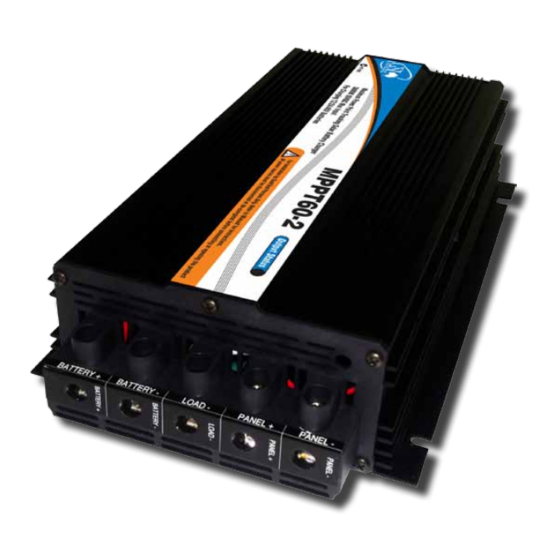Table of Contents
Advertisement
Quick Links
Model:
MPPT60-2
Page 1 of 8
This revolutionary maximum power point tracker solar charger was designed using the
technology that won GSL Electronics the prestigious EDN Innovation Awards 08' and 09'
and the Greentech Consensus Awards 09'. A simple, compact and low cost alternative.
Ideal for charging batteries from new low cost and high efficiency panels.
The MPPT 60-2 is designed to automatically charge 12V, 24V and 48V sealed and vented lead
acid batteries from silicon based pv panels such as monocrystalline, polycrystalline and thin film.
It has a built in Load Low Voltage Disconnect configurable as a Dawn to Dusk switch. It can be
connected to the MCM for remote control and full system parameter logging and display.
3400W Solar Battery Charger
Maximum Power Point Tracker
Please read these instructions before use
PATENT APPLIED FOR - 2010901565
Unit 2, 110 Station Road, Seven Hills ,NSW, 2147, Australia
Operating Instructions
MPPT60-2-R7
Advertisement
Table of Contents

Summary of Contents for GSL electronics MPPT60-2
- Page 1 Please read these instructions before use This revolutionary maximum power point tracker solar charger was designed using the technology that won GSL Electronics the prestigious EDN Innovation Awards 08’ and 09’ and the Greentech Consensus Awards 09’. A simple, compact and low cost alternative.
- Page 2 • The lowest Maximum Power Point system voltages are 18V for 12V batteries, 36V for 24V batteries and 72V for 48V batteries to ensure full power. MPPT60-2 General Information: • Green LED On – Battery Ok. • Green LED Flashing – Battery Low.
- Page 3 Model: 3400W Solar Battery Charger MPPT60-2 Maximum Power Point Tracker Page 3 of 8 Operating Instructions Please read these instructions before use BASIC WIRING OPTIONS: Permanent Load Connection Figure 1. (Figure 1): Simplest wiring option where the load is permanently connected...
- Page 4 Model: 3400W Solar Battery Charger MPPT60-2 Maximum Power Point Tracker Page 4 of 8 Operating Instructions Please read these instructions before use Wiring With Critical And Non Critical Loads (Figure 3): Critical loads are generally light loads which are powered under any condition. Non critical loads are loads which can be disconnected to ensure maximum on time for critical loads as well as to extend the life expectancy and reliability of the system.
- Page 5 Model: 3400W Solar Battery Charger MPPT60-2 Maximum Power Point Tracker Page 5 of 8 Operating Instructions Please read these instructions before use For optimal performance from panel and MPPT please use the following table to determine the best setup for your situation.
- Page 6 Model: 3400W Solar Battery Charger MPPT60-2 Maximum Power Point Tracker Page 6 of 8 Operating Instructions Please read these instructions before use Changing Battery Type Setting Procedure 1.Ensure all the MPPT wires are disconnected. 2.Remove 7 front panel screws and the front panel and slide out cover – see Figure 4.
- Page 7 Model: 3400W Solar Battery Charger MPPT60-2 Maximum Power Point Tracker Page 7 of 8 Operating Instructions Please read these instructions before use Figure 5 (Above): Vented Battery Setting Figure 6 (Above): Sealed Battery Setting MPPT FAQs Q: What is an MPPT? MPPT stands for Maximum Power Point Tracker and is a specialized converter designed to maintain the PV voltage at the level in which it delivers maximum power to the load or battery.
- Page 8 GSL Electronics (GSL) warrants that its products will, under normal use and service, be free of defects in material and workmanship for a period of two (2) years from the date of the original purchase by the customer as marked on the customer’s original invoice. Please refer to our website for full warranty and return information which can be found at http://www.gsl.com.au/faq.html...













Need help?
Do you have a question about the MPPT60-2 and is the answer not in the manual?
Questions and answers